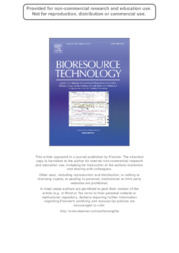Prevalence and persistence of potentially pathogenic and antibiotic resistant bacteria during anaerobic digestion treatment of cattle manure.
Prevalence and persistence of potentially pathogenic and antibiotic resistant bacteria during anaerobic digestion treatment of cattle manure.
Author(s): RESENDE, J. A.; SILVA, V. L.; OLIVEIRA, T. L. R. de; FORTUNATO, S. de O.; CARNEIRO, J. da C.; OTENIO, M. H.; DINIZ, C. G.
Summary: Anaerobic digestion figures as a sustainable alternative to avoid discharge of cattle manure in the environment, which results in biogas and biofertilizer. Persistence of potentially pathogenic and drug-resistant bacteria during anaerobic digestion of cattle manure was evaluated. Selective cultures were performed for enterobacteria (ENT), non-fermenting Gram-negative rods (NFR) and Gram-positive cocci (GPC). Antimicrobial susceptibility patterns were determined and a decay of all bacterial groups was observed after 60days. Multidrug-resistant bacteria were detected both the influent and effluent. GPC, the most prevalent group was highly resistant against penicillin and levofloxacin, whereas resistance to ampicillin, ampicillin-sulbactam and chloramphenicol was frequently observed in the ENT and NFR groups. The data point out the need of discussions to better address management of biodigesters and the implementation of sanitary and microbiological safe treatments of animal manures to avoid consequences to human, animal and environmental health.
Publication year: 2014
Types of publication: Journal article
Unit: Embrapa Dairy Cattle
Observation
Some of Embrapa's publications are published as ePub files. To read them, use or download one of the following free software options to your computer or mobile device. Android: Google Play Books; IOS: iBooks; Windows and Linux: Calibre.
Access other publications
Access the Agricultural Research Database (BDPA) to consult Embrapa's full library collection and records.
Visit Embrapa Bookstore to purchase books and other publications sold by Embrapa.

